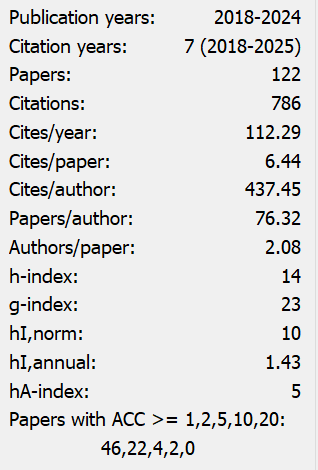Effect of the Socioeconomic Characteristics of Borrowers on Microcredit Repayment Behaviour: An Application to a Category II Microfinance Institution in Cameroon
Abstract
The purpose of this study is to determine the influence of socioeconomic characteristics of borrowers on microcredit repayment behaviour. The results of Probit regression statistical analysis using a database of 1805 individual loan contracts, credit records and follow-up files from 2007 to 2014 period by Community Credit of Africa (CCA) in Cameroon, reveal that educational level, awareness about the location of business and/or home of borrowers by the lender, sector of activities, availability of collateral, income stability, and personal wealth of borrowers have a statistically significant influence on microcredit repayment behaviour of borrowers. The outcome of the results shows that microfinance institutions should not only rely on financial indicators to assess the creditworthiness of borrowers. Other factors belonging to the social and economic characteristics of the borrowers are supposed to be integrated in credit risk models. These factors are sought to influence significantly microcredit repayment behaviour of borrowers.
References
Armendariz, B., & Morduch J. (2005). The Economics of Microfinance. MIT Press.
Arnaud, de S., & Ivan, Z. (1999). Economie Financière. Manuel, Dunod.
Atiya, A. F. (2001). Bankruptcy Prediction for Credit Risk Using Neural Networks: A Survey and New Results. IEEE Transactions on Neural Networks, 12(4), 929-935. https://doi.org/10.1109/72.935101
Banerjee, A. V., & Duflo, E. (2007).Repenser la pauvreté. World Development Indicators.
Bardos, M. (1989).Trois méthodes d’analyse discriminante. Cahiers économiques et monétaires, 33, Banque de France, 151-189.
Besley T., & Coate, S. (1995). Group lending, repayment incentives and social collateral. Journal of Development Economics, 46, 1-18. https://doi.org/10.1016/0304-3878(94)00045-E
Bester H. (1985). Screening vs. Rationing in Credit Markets with Imperfect Information. American Economic Review, 75, 850-855.
Black, F., & Scholes, M.(1993). The Pricing of Options and Corporate Liabilities. Journal of Political Economy, May- June, 637-659.
Blazy, R., Charlety, P., & Combier J. (1993). Les défaillances d'entreprises: des difficultés visibles plusieurs années à l'avance. Economie et Statistique, 101-111. https://doi.org/10.3406/estat.1993.5813
Boye, S., Hajdenberg, J., & Poursat, C. (2006). Le Guide de la microfinance", microcrédit et épargne pour le développement, Organisations, 303p.
Carmichael, J., & Pomerleano, M. (2002). The Development and Regulation of Non- Bank Financial Institutions. The World Bank. https://doi.org/10.1596/0-8213-4839-6
CGAP. (2017). Effective governance for Micro-finance Institutions. FOCUS, 7, mars.
Chevallier- Farrat. (1992). Pourquoi des banques? Revue d’Economie.
Ding, Y., Song, X., & Zen, Y. (2008). Forecasting financial condition of Chinese listed companies based on support vector machine. Expert Systems with Applications. https://doi.org/10.1016/j.eswa.2007.06.037
Fama, E. (1985). What's different about banks? Journal of Monetary Economics, 15. https://doi.org/10.1016/0304-3932(85)90051-0
Fama, E., & Jensen, M. C. (1983b). Separation of Ownership and Control. Journal of Law and Economics, 26(June), 301-326. https://doi.org/10.1086/467037
Godlewski, C. J. (2003). Excès de risque et défaillance bancaire: Une application des modèles de prévision de défaut aux banques des pays émergents.Working paper, Laboratoire de Recherche en Gestion et Economie.
Godquin, M. (2004). Microfinance Repayment Performance in Bangladesh: How to Improve the group lending”, Economic of Transition, 8(2), 401-420.
Guerin, I., & Roesch, M. (2005). Microcredit, Outil fragile. Le monde, 30 novembre.
Guerrien, B. (2002). Dictionnaire d'analyse économique’: microéconomie, macroéconomie, théorie des jeux, etc, 3ème édition. Repères, La découverte, Paris.
Hol, S., Westgaard, S., & Wijst, V. N. (2002). Capital structure and the prediction of bankruptcy. EWGFM Conference, Capital Markets Research (Bankruptcy Prediction).
Honohan (1997). Banking Systems faillures in develoing and transition countries: Diagnosis and predictions. WP, Bank of International Settlements. https://doi.org/10.2139/ssrn.860624
Hugon, P. (1996a). Incertitude, précarité et financement local: Le cas des économies africaines. Revue Tiers Monde, 37(145), 13-40. https://doi.org/10.3406/tiers.1996.5026
Huppi, M., & Feder, G. (1990). The Role of Groups and Credit Cooperatives in Rural Lending. The World Bank Research Observer, 5(2). https://doi.org/10.1093/wbro/5.2.187
Labie, M. (2004). Microfinance: un état des lieux. Monde en Développement. https://doi.org/10.3917/med.126.0009
Lanha, M. (2004). Efficacité relative du prêt de groupe avec caution solidaire.Séminaire de Recherche, Laboratoire d’Economie d’Orléans, Février 2004.
Ledgewood, J. (1998). Manuel de Microfinance: Une Perspective Institutionnelle et Financière. Banque Mondiale, Washington, D.C.
Lelart, M. (2005). De la Finance Informelle à la Microfinance. Savoirs Francophones.
Lewis, M. (1992). Modern Banking in Theory and Practice.Revue Économique. https://doi.org/10.2307/3501990
Li, H., & Sun, J. (2009). Gaussian case based reasoning for business-failure prediction with empirical data in China. Information Sciences, 179(1-2), 89-108. https://doi.org/10.1016/j.ins.2008.09.003
Liang, L., & Wu, D. (2003). An application of pattern recognition on scoring Chinese corporations financial conditions based on back propagation neural network. Computers and Operations Research, 32, 1115-112. https://doi.org/10.1016/j.cor.2003.09.015
Lobez, F. (1997). Banques et marchés du crédit. Presses Universitaires de France.
Lobez, F., & Vilanova, L. (2006). Microéconomie bancaire.Collection Finance, PUF. https://doi.org/10.3917/puf.lobe.2006.01
M.I.X. (2009). Microfinance Information Exchange.
Markowitz, H. (1952). Portfolio Selection. Journal of Finance, March 1952, 77-91. https://doi.org/10.2307/2975974
Mayers, D., & Smith, C. W. (1981). Contractual provisions, Organisation structure and conflict control in insurance markets. Journal of Business. https://doi.org/10.1086/296138
Mayoukou, C. (2000). La microfinance en Afrique Centrale: état des lieux et perspectives de développement. Techniques financières et développement, 59-60.
Montalieu, T. (2002). Les institutions de micro-credit: Entre promesses et doutes. Quelles pratiques bancaires pour quels effets? Mondes en Développement, 119. https://doi.org/10.3917/med.119.0021
Morduch, J. (1998). Does microfinance really help the poor? New evidence from flagship programme in Bangladesh. Department of Economics, Harvard University.
Muhamad, Y. (1997). Vers un monde sans pauvreté. LATTES, Paris.
Ntieche, A. (2018). Contrats de dette et comportements des emprunteurs dans le secteur de la microfinance, thèse de Doctorat (PhD), Université de Douala.
O.C.C. (1988). Bank failure: An evaluation of the factors contributing to the failure of national banks.
Pankaj, J., & Moore, M. (2003). What Makes Micro-credit Programmes Effective? Fashionable Fallacies and Workable Realities. Institute of Development Studies.
Pindado, J., & Rodrigues, L. F. (2001). Parsimonious models of financial insolvency in small companies. Working Paper, SSRN Working Paper Series. https://doi.org/10.2139/ssrn.283782
Tamari, D. (1964). Sur quelques problèmes d’associativité. Annales scientifiques de l’Université de Clermont-Ferrand 2, tome 24, série Mathématiques, 3, 91-107.
Varadharajan, S. (2004). Explaining participation in rotating savings and credit associations (roscas): Evidence from indonesia. Department of Economics, Cornell University.

This work is licensed under a Creative Commons Attribution 4.0 International License.
Copyright for this article is retained by the author(s), with first publication rights granted to the journal.
This is an open-access article distributed under the terms and conditions of the Creative Commons Attribution license (http://creativecommons.org/licenses/by/4.0/).


























